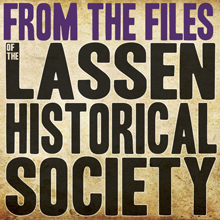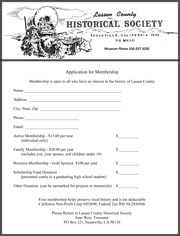

by Susan Couso
The Honey Lake Valley area has been home to many unique individuals, who might be more appropriately titled ‘characters.’ One of these very interesting citizens was James Pierson Beckwourth. Beckwourth was a peripatetic explorer who readily accepted and exploited new adventures.
He was the son of Sir Jennings Beckwirth and one of Beckwirth’s slaves. James Beckwourth noted that he was the third of thirteen children. This common tale of life in the early south was made exceptional by the fact that Jennings Beckwirth, (married to Catherine Miskell), packed up his family, both white and black, and moved them to St. Louis, Missouri around 1800. Here, Jennings Beckwirth manumitted his twenty-two slaves.
Sir Jennings Beckwirth was an avid hunter and sportsman and had spent much time in the wilderness around St. Louis. His stories of his sporting exploits and the tales of life in the Indian camps must have aroused yearnings in young James, for when he was but eight years old, James, (who for some reason used the spelling ‘Beckwourth’) ran off to join the circus.
Things did not go as planned, and the dejected boy was returned to his father. This marked a ‘turning point’ for James, as his father then had him apprenticed to a blacksmith.
But a blacksmith’s profession was not for a wanderer and adventurer, and James only spent a few miserable months at the smithy before escaping the confines of an unwanted education in metalwork.
James had plans. He opened his own business selling popcorn, at which he did fairly well before securing a bit part in the theater. The troupe traveled from town to town, which suited James completely, but the actors soon realized, as most actors do, that they were ‘dead broke’. A change of venue as well as a change of occupation was necessary.
And thus, James Pierson ‘Jim’ Beckwourth set off to see just what awaited him in the world.
He reportedly attended a Mountain Man rendezvous in 1825 in Wyoming, and by 1829, he was becoming famous as a trapper, explorer, fur trader, guide, innkeeper, mountain man, scout, gambler, and avid storyteller.
He spent many years among the Native People of the West, most notably, the Crow Nation, where he reportedly married several times and had numerous children.
In 1837, he participated in the Seminole War in Florida, but no one seems to know just what he did. He boarded a boat out of New Orleans, but soon became terribly seasick. The boat was then stranded on a sand bar for two weeks. James eventually made it to Florida, but then soon returned to the west.
Beckwourth is noted for establishing trading posts, among other ventures. His explorations into unknown territory and setting up a bit of civilization for trappers and travelers alike did take courage and work. Beckwourth played a major role in the creation of Pueblo, Colorado.
He also made quite a profit selling whiskey to the Cheyenne and operating saloons in New Mexico, where he is rumored to have had a ‘side business’ illegally procuring horses!
As the Gold Rush began in 1849, James went to Sonoma, California, and then on to Sacramento, where he was a professional gambler.
By 1850, he had ’discovered’ an easy pass through the Sierra Nevada Mountains, in what was to become Lassen County. Beckwourth’s Pass is still a well-known pass today. He is credited with finding three other passes, but only Beckwourth’s Pass was anointed as an official historic landmark (in 1939).
Beckwourth’s first cabin in Honey Lake Valley burned in 1852 and was quickly replaced by the cabin now on display near the town of Portola. The City of Portola thinks this may actually be Beckwourth’s third cabin, and the little museum has information to support this, but its structure harks back to the methods used during those early days in Virginia.
James Beckwourth’s life was indeed unique and interesting, if not a bit ambiguous. His biography, The Life and Adventures of James P. Beckwourth, was written by another unique individual named Thomas P. Bonner and published in 1856.
Beckwourth has been dubbed a ‘gaudy liar’, an ‘immortal liar’, an ‘audacious braggart and prevaricator’, and his biography deemed as, “so much effluvium washing down the pike,” but many researchers consider the work to be generally accurate and, at the very least, a look into what it was like to be an African American man in the ‘Wild West’.
A question remains as to whether Beckwourth, with his very limited literacy, told these tall tales, or whether Bonner embellished on his own. Bonner was considered a drunkard and is said to have absconded with the book’s proceeds, leaving Beckwourth to move on to new adventures.
But most all accounts recall that Beckwourth was an intriguing, striking fellow. He stood at least six-feet tall and had a strongly built muscular body. He let his long black hair grow to his waist and sometimes braided it with ribbons and other adornment. He normally dressed in the Crow tradition with earrings, beading, and Crow leggings.
His appearance and bravado must have enticed the female population as Beckwourth had several wives. He supposedly fathered many children, but this can never be confirmed.
At least two documented offspring; Matilda Mary Beckwourth and George W. Beckwourth existed. Matilda married a man named Brown, and then faded from records. George worked as a postman in Colorado, and on Christmas day, 1876, was kicked in the head by a horse. He died, and his body was buried at the Crow Settlement Cemetery in Laramie, Wyoming.
In 1866, James Beckwourth got a job working as a scout and guide to help move U.S. Army troops from Fort Smith, Montana to a Crow Settlement in Wyoming. The facts are as sketchy as the other facts of Beckwourth’s life, but he apparently made some enemies at Fort Smith when he refused to help the U.S. Army go to war against the Crow nation.
Soon after leaving the fort, he became ill, but he made it to his beloved Crow country shortly before expiring. Many say that he had been poisoned at the fort.
Beckwourth’s body was placed on a platform, as per the Crow custom, until his body was buried at the Crow Indian Settlement Cemetery. And, so, a remarkable man with a remarkable life finally found where he belonged.
 If you are a fan of our weekly history stories you should join the Lassen County Historical Society! It’s a fun way to be a part of our county’s rich history. When you sign up, you’ll receive regular Historical Society newsletters with interesting stories and information. Membership is open to anyone with an interest in area history.
If you are a fan of our weekly history stories you should join the Lassen County Historical Society! It’s a fun way to be a part of our county’s rich history. When you sign up, you’ll receive regular Historical Society newsletters with interesting stories and information. Membership is open to anyone with an interest in area history.
Through your membership you help preserve local history. You can download a membership application by clicking here.





